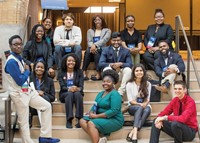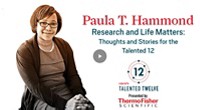Advertisement
Grab your lab coat. Let's get started
Welcome!
Welcome!
Create an account below to get 6 C&EN articles per month, receive newsletters and more - all free.
It seems this is your first time logging in online. Please enter the following information to continue.
As an ACS member you automatically get access to this site. All we need is few more details to create your reading experience.
Not you? Sign in with a different account.
Not you? Sign in with a different account.
ERROR 1
ERROR 1
ERROR 2
ERROR 2
ERROR 2
ERROR 2
ERROR 2
Password and Confirm password must match.
If you have an ACS member number, please enter it here so we can link this account to your membership. (optional)
ERROR 2
ACS values your privacy. By submitting your information, you are gaining access to C&EN and subscribing to our weekly newsletter. We use the information you provide to make your reading experience better, and we will never sell your data to third party members.
Environment
Power To The Students
Grad students produce high-profile symposium as part of an innovative education initiative
by Stephen K. Ritter
May 5, 2008
| A version of this story appeared in
Volume 86, Issue 18

TAKE A HANDFUL of motivated graduate students, give them a daunting challenge, then stand back and watch what happens. That's the concept of the Graduate Student Symposium Planning Committee (GSSPC), an initiative launched by the ACS's Division of Chemical Education (CHED) in which graduate students organize and host a symposium at an ACS national meeting.
In the latest edition of the program, a group of graduate students from the University of California, Los Angeles, produced "NanoPower: Creating Energy for the Future," a symposium held during last month's ACS national meeting in New Orleans. The symposium, which took more than a year for the students to put together, focused on the impact of nanoscience in developing cleaner and more efficient energy technologies. It was sponsored by the Division of Industrial & Engineering Chemistry.
"We came into this project with only a vague idea of what planning a symposium entailed," noted Kirsten Griffiths, who served as GSSPC chair for the UCLA team. "But I think as a group we've all left with a better idea of how ACS works, how scientific meetings come to be, and how we can really make a difference using our individual talents." Griffiths is a graduate student in J. Fraser Stoddart's group working on the synthesis of molecular Borromean rings via hydrogen-bonding interactions.
GSSPC had its genesis back in the fall of 2004, when incoming CHED Program Chair Catherine H. Middlecamp, director of the Chemistry Learning Center at the University of Wisconsin, Madison, teamed up with five Wisconsin graduate students to organize the first symposium.
The graduate students have control of their event from its inception, Middlecamp explained to C&EN. They choose a theme, invite the speakers, set up the meeting program in ACS's online database, raise funds for travel and for food and drinks, advertise their symposium, and deal with on-site meeting logistics. Each GSSPC is also in charge of recruiting and mentoring a future GSSPC to ensure the program continues meeting after meeting, she said. Middlecamp gives a lot of credit to former University of Illinois, Urbana-Champaign, graduate student Dorothy J. Miller, who is now a graduate fellow at the National Academies, for chairing the 2006 GSSPC that developed the committee's current operating procedures.
During her 2005–07 tenure, Middlecamp tried to strike a balance of staying out of the students' way, yet at the same time being there to help them navigate the terrain of national meeting programming, she said. "The graduate students are the future of ACS, and it's important to put the reins in their hands. We just need to watch gently to make sure they keep the cart on the road. More power to the grad students!"
For the New Orleans meeting, the UCLA group set up what turned out to be a stellar all-day symposium, complete with lectures, a panel discussion, and an evening reception. The 10 invited speakers included notable researchers in the fields of solar cells, artificial photosynthesis, and materials science. For example, Nobel Laureate Alan J. Heeger of UC Santa Barbara spoke about self-assembled polymeric nanomaterials for fabricating low-cost solar cells.
In fact, the importance of the symposium and the prestige of the speakers prompted ACS President Bruce E. Bursten to select it as a meeting Presidential Event. And if there's one way to gauge the success of an ACS symposium, it's by how many people attend. By that measure, the NanoPower symposium was a knockout, with a standing-room crowd of about 200 people packed into the meeting room.
"We are all really proud of how our symposium went," committee member Sarah Angelos said. She is a UCLA graduate student in Jeffrey I. Zink's group working on functional silicate materials prepared by sol-gel techniques.
"Prior to the meeting, we were excited by the caliber of speakers who had agreed to participate," Angelos added. "And at the meeting it was rewarding to see how well attended the symposium was. The opportunity to organize and host a symposium at a national meeting helped each of us to feel like integrated, contributing members of ACS."
The challenges of setting up the symposium came at the UCLA team from two sides: time management and keeping a handle on the enormity of the task, Griffiths said.
"As graduate students, we are all under pressure from our advisers to produce results," Griffiths explained. "So at times we had to help each other with different parts of the symposium so that no one fell behind in their research. And as a graduate student group, there was no one there to chastise us if we would have fallen behind. It was up to us to decide what needed to be done, prioritize, and keep on task."
"Students approach something new like organizing a symposium in an innocent way—it's a bit like making fresh footprints in new-fallen snow," commented Daniel G. Nocera, a chemistry professor at Massachusetts Institute of Technology who was one of the symposium speakers. But as the GSSPC students in New Orleans showed, he noted, "their inexperience can make for a great bit of organization and help them do a good job."
During his talk, Nocera discussed the challenge of generating enough energy for future needs. He provided some examples from his research that include the catalytic splitting of water into oxygen and hydrogen, which can be used to power fuel cells.
The GSSPC program "is absolutely fantastic," added Debra R. Rolison, head of Advanced Electrochemical Materials at the Naval Research Laboratory in Washington, D.C., who was another of the symposium speakers. Rolison discussed the "architectural design" and "interior decoration" of three-dimensional nanomaterials that can be used in a host of energy applications.
One thing the students understand is that the organizing process and selecting a topic tunes them in to what subjects might be missing in their curriculum, Rolison observed. "It also helps them to identify important new directions that they can pursue as they start their careers," she said.
GSSPC PROGRAMMING is set to continue at the ACS national meeting in Philadelphia in August, when students from the University of Connecticut will host the symposium "Transitioning into Green Chemistry." Following that, a team of George Washington University graduate students will be in charge of a symposium at the national meeting in Salt Lake City next March. As part of the GSSPC program, some of the George Washington students were in New Orleans tagging along with the UCLA group to learn the ropes.
"We really hope this program continues to grow into something that people come to look for at each ACS meeting," Griffiths said. "It is such a positive opportunity for both graduate students and ACS."





Join the conversation
Contact the reporter
Submit a Letter to the Editor for publication
Engage with us on Twitter